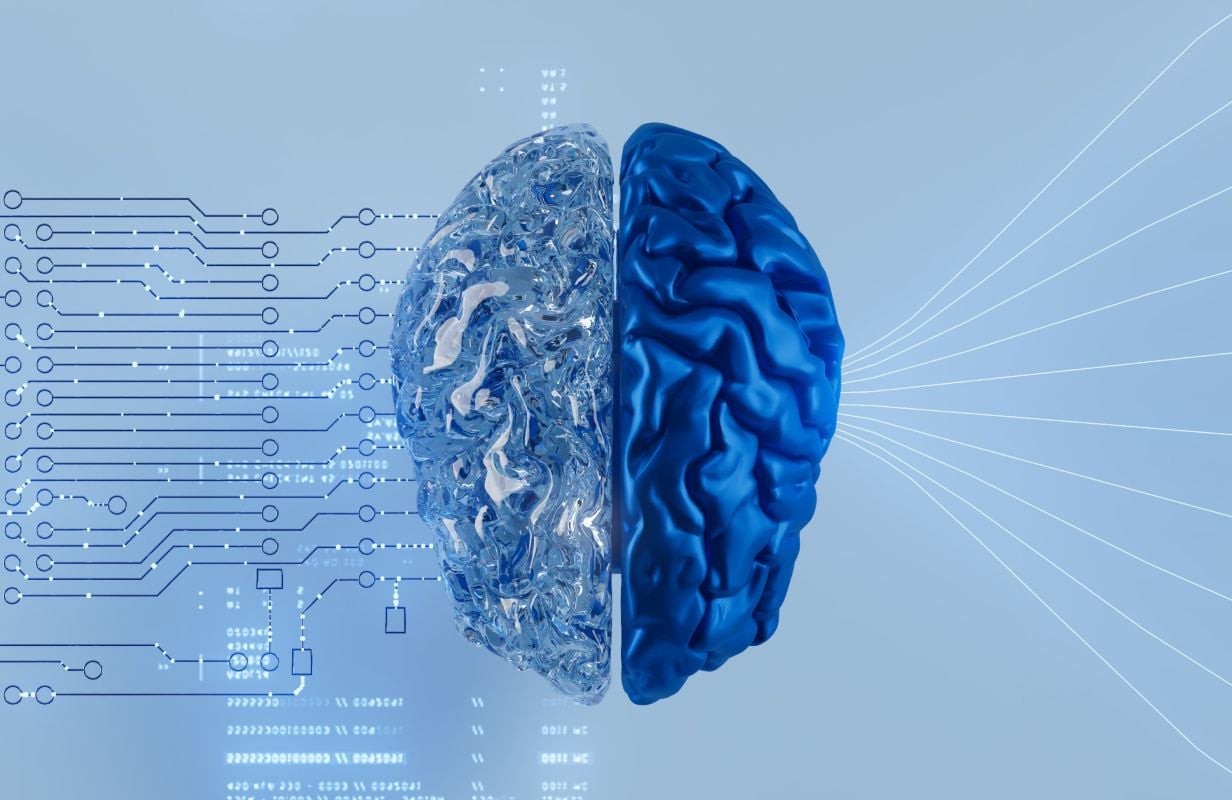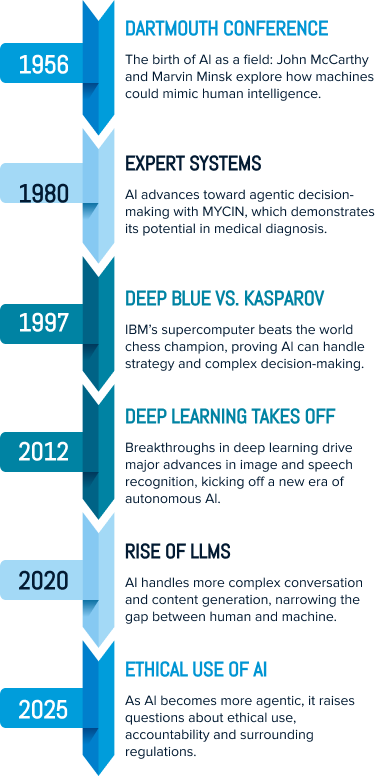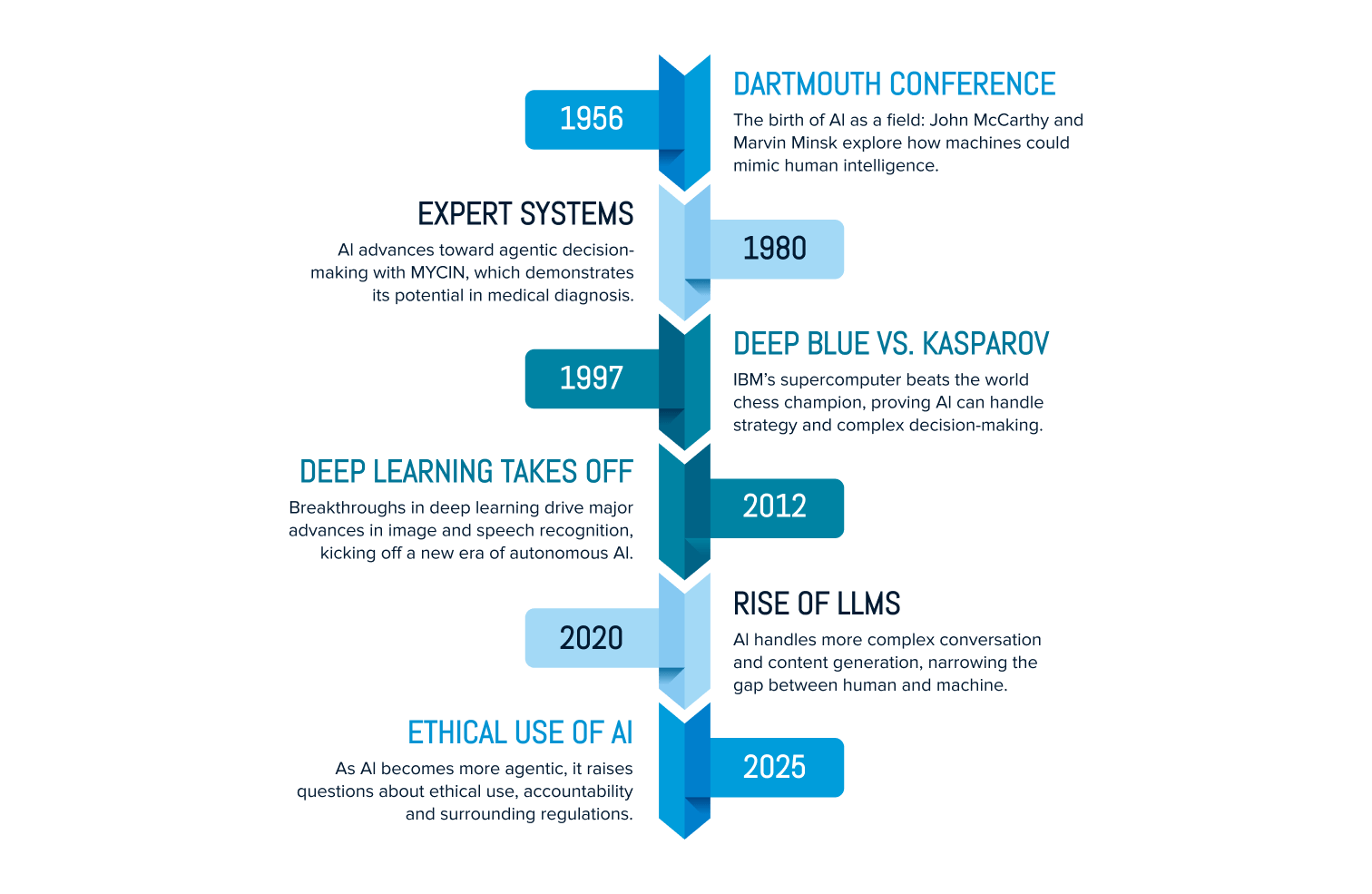
Autonomous
Decision-Making
Advancing Problem-Solving in AI
The Change Agent
Technology investments—especially in AI—remain top priorities for businesses right now to improve efficiency and problem-solving. Agentic AI, the latest generation of AI for enterprises, offers the groundbreaking ability to translate knowledge into autonomous action to facilitate productivity and innovation.
Reimagining Problem-Solving With Human-Machine Collaboration
Agentic AI operates through autonomous AI agents specifically designed to perform complex tasks by interpreting contextual information, making decisions based on that interpretation and executing actions aligned with predetermined objectives. This functionality bridges the traditional gap between static programming approaches and the dynamic adaptability required for modern enterprise challenges. By combining sophisticated decision-making capabilities with contextual understanding and adaptive behavior, agentic AI enables the automation of intricate workflows that previously required substantial human oversight and intervention.
The operational foundation of agentic AI rests on several key components working in coordinated harmony. Decision-making algorithms represent a central element, allowing the system to evaluate multiple options and select appropriate actions based on goals, constraints and contextual factors. These algorithms typically employ probability assessments, pattern recognition and objective alignment to make choices that optimize outcomes within given parameters. This capability enables agentic AI to navigate complex decision landscapes autonomously, making judgment calls that previously required human expertise.

Reinforcement learning mechanisms provide agentic AI with the ability to improve through experience, gradually enhancing performance by understanding which actions lead to desired outcomes under various conditions. This learning approach allows these systems to evolve and refine their strategies over time without explicit reprogramming. Essentially, they “learn by doing” through repeated interactions with their operational environment. The result is continuous improvement in performance and decision quality as the system accumulates experiential data and refines its understanding of effective approaches.

Contextual analysis capabilities enable agentic AI to interpret the nuances of situations, understanding not just explicit instructions but implicit context that informs more appropriate responses. This sophisticated level of comprehension allows the system to grasp stated requirements and unstated expectations, leading to more intuitive and appropriate actions across diverse scenarios. When combined with adaptive behavior mechanisms that modify strategies based on new information or changing circumstances, this contextual understanding ensures agentic AI remains effective even in dynamic and evolving environments.
More sophisticated implementations often incorporate multi-agent coordination architectures, where multiple specialized AI agents collaborate to achieve broader objectives. In these systems, individual agents focus on specific aspects of a task while coordinating their efforts through structured communication and task allocation frameworks. This distributed approach enables more complex problem-solving by combining specialized capabilities into coherent, coordinated action toward shared goals. Despite their dependence on initial programming and high-quality training data to develop their decision-making capabilities effectively, organizations will see increasing benefits in leveraging the remarkable autonomy and adaptability of agentic AI as a driver of business modernization.
Multiple industry forecasts, corroborated by extensive research across sectors, predict that AI agents will automate up to 70% of office work tasks within the next decade.1

Core Components and Architecture
A typical multi-agent system architecture consists of:
- Specialized agents: individual AI agents with specific functions and capabilities
- Shared memory: a repository for communication and knowledge sharing between agents
- Orchestration layer: coordinates agent activities and workflow
- Data storage and retrieval layer: manages information access and storage
- Service layer: delivers AI capabilities across platforms
History of Agentic AI
Figure 1. "History of Agentic AI" 2
Market Perspective
Nader Mherabi, EVP, vice dean, and chief digital and information officer at NYU Langone Health, and David Brauchler, technical director at NCC Group, share how businesses can leverage agentic AI to boost business operations with effective, adaptable solutions across industries.
Agentic AI Considerations From NYU Langone Health and NCC Group
How should companies implement agentic AI?
Nader Mherabi (NYU Langone Health): When companies start deploying AI, they should put together a strategic plan to make sure that the right technology is being applied to the right use case. You can’t have AI outside of the workflow because people won’t use it.

Will data be secure?
David Brauchler (NCC Group): Companies should recognize potential security risks associated with agentic AI. Everything that you add to your application environments or networks is additional attack networks that you have to govern. Security testing should be conducted when considering adding AI to systems and platforms lacking design that includes AI or AI-related risk in mind.

How will agentic AI be monitored?
Nader Mherabi (NYU Langone Health): Agentic AI is not a set-it-and-forget-it type of application. It needs to be continuously monitored to ensure that the data is accurate, is being used appropriately and benefits end users.
Our Perspective
Organizations can balance human creativity with AI efficiency and data access by implementing autonomous AI agents for better decision-making, cost savings and competitive advantage.
Agentic AI Business Impact and Applications
The practical applications of agentic AI already demonstrate transformative value across many business functions and industries, optimizing processes that previously required substantial human oversight and intervention. By combining autonomous decision-making with contextual understanding and adaptive behavior, these systems enable organizations to achieve unprecedented levels of efficiency, responsiveness and innovation at scale. From customer service enhancements to operational optimizations and scientific breakthroughs, agentic AI for enterprises is reshaping how organizations approach complex challenges and opportunities.

Ethical Considerations and Accountability
As enterprise AI solutions gain greater decision-making autonomy, determining responsibility when an autonomous system makes errors or produces unintended consequences becomes increasingly complex, highlighting the importance of clear accountability frameworks across the business, such as the National Institute of Standards and Technology (NIST) AI Risk Management Framework (AI RMF).
Aligning AI systems with human values and ethical principles is critical during implementation. This will prevent actions that conflict with organizational values or broader societal norms, particularly in complex or ambiguous situations where multiple competing priorities exist. Explicit value alignment processes, ethical review mechanisms and continuous monitoring for value drift are essential elements of responsible agentic AI implementation.

Environmental Impact Concerns
The environmental footprint of AI systems requires serious review during implementation planning and ongoing operations. The proliferation of data centers housing AI infrastructure contributes significantly to hazardous electronic waste generation. Implementation must incorporate sustainable life cycle management from deployment through eventual decommissioning to minimize environmental impact.
AI infrastructure development and operation depend heavily on critical minerals and rare earth elements. These components are frequently extracted through mining practices with substantial environmental and social consequences as the elements often appear in electronic waste streams. Although proper recycling and resource recovery programs aren’t available, some strategies could reduce e-waste generation by up to 86%, including using equipment for longer (lifespan extension), refurbishing and reusing components, and designing hardware to facilitate recycling and upgrades.
Data centers powering AI infrastructure also utilize massive electricity resources that contribute to greenhouse gas emissions, depending on energy sources. Similarly, water consumption for cooling systems can further strip scarce resources in many regions, necessitating strategies like renewable energy adoption, efficiency improvements and water conservation measures for sustainable technology implementation.

Technical and Operational Challenges of Agentic AI
Implementing multi-agent agentic AI solutions on cloud platforms presents significant technical challenges but offers powerful capabilities for advanced AI automation. Organizations can develop effective implementation strategies by understanding the foundations of agent communication, orchestration, scalability and security.


Benefits of Agentic AI as a Strategic Technology Investment
Transforming Customer Experiences
In customer service environments, agentic AI has already achieved significant operational scale, orchestrating intelligence and automation across multiple service activities simultaneously. These systems demonstrate remarkable capability to analyze customer sentiment, review historical interaction data, access relevant company policies and respond to needs based on this comprehensive understanding. The result is a more personalized, effective service experience that addresses customer needs holistically rather than through fragmented interactions or siloed information access.
Enhancing Operational Efficiency
Agentic AI delivers significant operational efficiency improvements across diverse sectors by automating complex, time-intensive tasks that previously required substantial human involvement. Autonomous AI agents can process and analyze massive data volumes faster than human operators, accelerating decision-making processes and streamlining workflows. In manufacturing environments, for example, agentic AI can autonomously manage and optimize production schedules in real time, minimizing downtime and maximizing output without requiring constant human supervision or intervention.
Driving Innovation and Discovery
Some of the most transformative agentic AI use cases emerge in domains requiring complex problem-solving, creativity and discovery processes. Scientific research and materials development provide compelling examples, where agentic AI capabilities extend far beyond identifying potential compound formulations. These systems can also evaluate supplier options based on priorities like cost efficiency or delivery timing, place orders for necessary materials, and coordinate the entire discovery-to-implementation process autonomously. This comprehensive approach accelerates innovation cycles while reducing the administrative burden on research teams.







